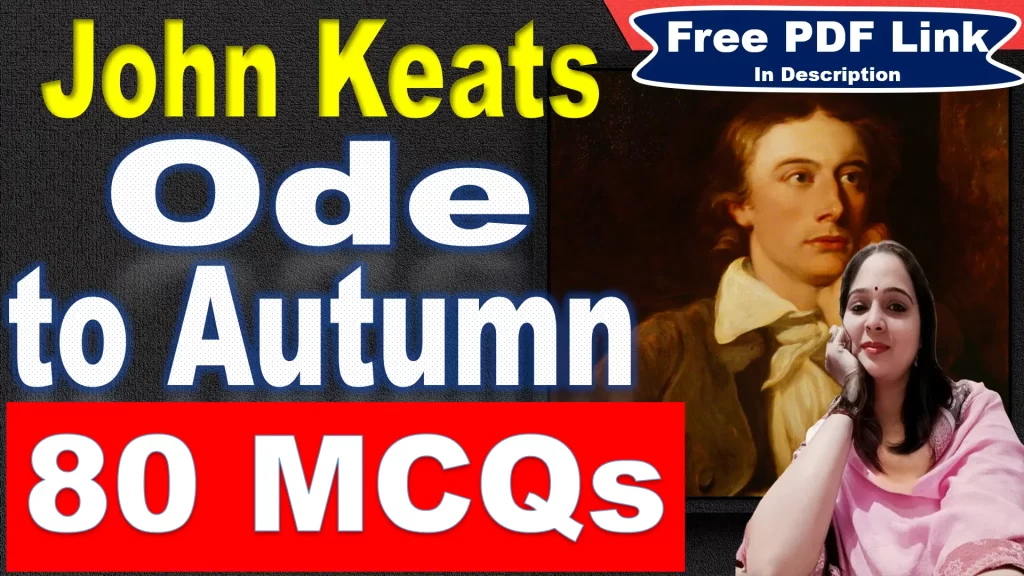
1. Who is the author of the poem Ode to Autumn?
A) William Wordsworth
B) John Keats
C) Samuel Taylor Coleridge
D) Percy Bysshe Shelley
Answer: B) John Keats
Explanation: John Keats, an English Romantic poet, wrote Ode to Autumn in September 1819. He was known for his deep appreciation of nature, beauty, and emotions. Keats is famous for writing several odes, including Ode to a Nightingale and Ode on a Grecian Urn. Unlike some poets who focused on philosophy or social issues, Keats concentrated on the sensory experience of nature. Ode to Autumn is one of his most celebrated works, written during his time in Winchester, England.
2. Ode to Autumn is a poem in which literary form?
A) Sonnet
B) Ballad
C) Elegy
D) Ode
Answer: D) Ode
Explanation: An ode is a type of poem that praises or celebrates something. Keats wrote Ode to Autumn as a tribute to the beauty and richness of the autumn season. Odes usually have a formal structure and are lyrical, meaning they express deep emotions. This poem does not tell a story like a ballad, nor does it express sorrow like an elegy. Instead, it glorifies the season of autumn, describing its abundance, peacefulness, and transition towards winter.
3. What is the primary theme of Ode to Autumn?
A) The beauty of nature and transience of life
B) The sorrow of lost love
C) The power of imagination
D) The struggles of human existence
Answer: A) The beauty of nature and transience of life
Explanation: The main theme of Ode to Autumn is how nature is both beautiful and temporary. The poem shows autumn as a season full of ripe fruits, golden fields, and warm colors, but also hints at the passage of time leading to winter. This reflects Keats’ belief that life is fleeting, and we should appreciate its beauty while it lasts. The poem encourages readers to embrace change rather than mourn the past. Keats does not focus on sadness or struggle but on celebrating the present moment.
4. How many stanzas does the poem Ode to Autumn have?
A) Two
B) Three
C) Four
D) Five
Answer: B) Three
Explanation: The poem consists of three stanzas, each with eleven lines. Each stanza captures a different aspect of autumn:
The first stanza focuses on the ripeness and abundance of autumn, with fruits and crops at their peak.
The second stanza personifies autumn as a figure who observes and enjoys the season’s activities.
The third stanza describes the sounds and sights of late autumn, hinting at the arrival of winter.
5. Which season is personified in the poem?
A) Winter
B) Spring
C) Autumn
D) Summer
Answer: C) Autumn
Explanation: The poem personifies autumn, meaning it is given human-like qualities. Keats describes autumn as a close friend of the sun, working together to ripen the fruits. In the second stanza, autumn is seen as a relaxed figure sitting on a granary floor or watching cider being pressed. This personification makes autumn feel alive, as if it is an actual character in the poem. Instead of treating autumn as just a season, Keats makes it seem gentle, generous, and calm.
6. What does Keats describe autumn as in the poem?
A) A time of decay and sadness
B) A season of richness and fulfillment
C) A period of harshness and cruelty
D) A dull and lifeless time
Answer: B) A season of richness and fulfilment
Explanation: Keats presents autumn as a season of abundance, warmth, and fulfillment. He describes trees bending under the weight of ripe apples, gourds swelling, and bees buzzing around flowers. Instead of showing autumn as a time of decay or sadness, he highlights its role in the cycle of life. The season is portrayed as peaceful, filled with golden light and soft winds. Rather than dreading the end of summer, Keats encourages readers to enjoy the beauty of autumn while it lasts.
7. What is the rhyme scheme of the first stanza?
A) ABABCDCD
B) AABBCCDD
C) ABABCDEDCCE
D) ABCDEFGHIJ
Answer: C) ABABCDEDCCE
Explanation: The rhyme scheme of the first stanza is ABABCDEDCCE. This means that the last words of certain lines follow a specific pattern:
A (mists)
B (sun)
A (bless)
B (run)
C (trees)
D (core)
E (shells)
D (more)
C (bees)
C (cease)
E (cells)
This structured rhyme scheme gives the poem a rhythmic and musical quality, making it pleasant to read. The other two stanzas follow a slightly different but similar pattern.
8. What does autumn conspire with in the poem?
A) The moon
B) The maturing sun
C) The wind
D) The rain
Answer: B) The maturing sun
Explanation: In the first stanza, Keats writes that autumn conspires with the maturing sun to ripen fruits and ensure a rich harvest. This personification suggests that autumn and the sun work together to make nature productive. The sun plays a crucial role in helping crops grow, while autumn brings them to full ripeness. This collaboration between nature’s elements highlights the harmony in the seasonal cycle. Instead of showing autumn as an ending, Keats presents it as a time of completion.
9. What does the poet say about bees in Ode to Autumn?
A) They are dead by autumn
B) They think summer will never end
C) They migrate to warmer places
D) They become aggressive in autumn
Answer: B) They think summer will never end
Explanation: In John Keats’ “Ode to Autumn,” the poet describes bees in a way that aligns with option B. Specifically, in the second stanza, Keats writes:
“And still more, later flowers for the bees,
Until they think warm days will never cease,
For Summer has o’er-brimm’d their clammy cells.”
Here, the bees are portrayed as being lulled into a sense of endless summer due to the abundance of flowers and warmth, even as autumn progresses. Thus, the correct answer is: B) They think summer will never end
10. Which of the following is NOT an activity described in the second stanza?
A) Sitting on a granary floor
B) Sleeping in a half-reaped furrow
C) Watching birds migrate
D) Watching the last oozings of cider
Answer: C) Watching birds migrate
Explanation: The second stanza describes different ways that autumn is personified. It shows autumn as:
Sitting on a granary floor, watching the harvest
Sleeping in a half-reaped furrow, feeling relaxed
Observing the last oozings of cider, as juice slowly drips from apples
However, it does not mention watching birds migrate. That idea appears in the third stanza, where Keats describes swallows gathering in the sky, preparing to leave for winter. This shows the passage of time and the approach of colder days.
11. What kind of sounds are described in the third stanza?
A) Loud music of festivals
B) The mournful cries of nature
C) The chirping of crickets and bleating of lambs
D) The howling of the wind
Answer: C) The chirping of crickets and bleating of lambs
Explanation: In the third stanza, Keats shifts from visual imagery to auditory imagery. He describes the chirping of hedge-crickets, the bleating of full-grown lambs, and the whistling of red-breasts (robins). These sounds create a sense of calm and completion, capturing the essence of late autumn. Unlike spring, which is full of vibrant bird songs, autumn’s music is gentler and more subdued, emphasizing the peaceful and fulfilling end of the season.
12. How does Keats personify autumn?
A) As a busy harvester
B) As a sleeping old man
C) As a dancing fairy
D) As a fierce warrior
Answer: A) As a busy harvester
Explanation: Keats personifies autumn in the second stanza by describing it as an active and hardworking figure, much like a farmer or harvester. Autumn is seen sitting on a granary floor, watching the last oozings of cider, and resting in a half-reaped furrow. By doing this, Keats makes the season feel alive, as if it is a human being engaged in the harvest. This gives the poem warmth and makes autumn seem like a kind and generous giver.
13. What is the mood of the poem?
A) Sad and melancholic
B) Joyful and celebratory
C) Angry and rebellious
D) Hopeful and romantic
Answer: B) Joyful and celebratory
Explanation: Unlike some of Keats’ other poems, which focus on sadness or longing, Ode to Autumn is a celebration of nature’s beauty and abundance. The poet does not dwell on the fact that autumn will soon end; instead, he focuses on its richness and fulfillment. The mood is warm, content, and appreciative, as Keats highlights the joys of harvest time, the sounds of nature, and the golden beauty of the season.
14. What happens to the swallows at the end of the poem?
A) They begin to gather for migration
B) They stop singing
C) They start nesting
D) They die
Answer: A) They begin to gather for migration
Explanation: The last image of the poem shows swallows gathering in the sky, preparing to migrate before winter arrives. This moment signals the passing of time and the natural cycle of the seasons. While the poem does not mention winter directly, the gathering of swallows hints at the changing of the season. This image suggests both an ending and a new beginning, reinforcing the poem’s theme of life’s constant transitions.
15. What does the phrase “barred clouds bloom the soft-dying day” suggest?
A) The beauty of the sunset
B) The arrival of winter
C) The end of autumn
D) The sorrow of losing summer
Answer: A) The beauty of the sunset
Explanation: In this line, Keats compares the evening sky to a blooming flower, describing how striped (barred) clouds turn pink and red at sunset. The phrase “soft-dying day” is a metaphor for the setting sun, showing that the day is fading gently and beautifully rather than ending abruptly. This line captures the calm and golden atmosphere of an autumn evening, reinforcing the poem’s theme of accepting the passage of time with grace.
16. What kind of imagery dominates the poem?
A) Visual and auditory
B) Tactile and olfactory
C) Gustatory and kinetic
D) Abstract and philosophical
Answer: A) Visual and auditory
Explanation: Keats paints vivid pictures in the reader’s mind using visual imagery (descriptions of ripe fruits, golden fields, and pink sunsets) and auditory imagery (the chirping of crickets, the bleating of lambs, and the twittering of swallows). These sensory details make the poem feel rich and immersive, allowing the reader to see and hear the beauty of autumn. Keats is known for his sensory writing, and Ode to Autumn is a perfect example of this.
17. What does the poet urge autumn not to think about?
A) The coming of winter
B) The lost songs of spring
C) The fading flowers
D) The hard work of harvesting
Answer: B) The lost songs of spring
Explanation: In the third stanza, Keats asks, “Where are the songs of spring? Ay, where are they?”, but immediately reassures autumn that it has its own music too. This suggests that autumn should not worry about what is gone (spring) but instead appreciate its own unique beauty. This reflects the broader theme of the poem: accepting change and living in the present rather than longing for what has passed.
18. What is the final image in the poem?
A) A farmer harvesting crops
B) Birds gathering in the sky
C) Leaves falling on the ground
D) The sun setting behind a hill
Answer: B) Birds gathering in the sky
Explanation: The last line of Ode to Autumn describes swallows flying in the sky, a natural sign that autumn is ending. This image suggests transition and movement, as the birds prepare to leave for warmer places. Keats does not end the poem with a sense of loss but rather with a gentle farewell to autumn. The final image reinforces the idea that nature follows a continuous cycle, and just as autumn fades, a new season will begin.
19. What is the central message of Ode to Autumn?
A) The hardships of agricultural life
B) The eternal nature of beauty
C) The transience and beauty of life
D) The power of human creativity
Answer: C) The transience and beauty of life
Explanation: The poem highlights how life is temporary, but every season has its beauty. Keats describes autumn as a season of abundance, but also hints at the arrival of winter. This reflects the idea that everything in life is constantly changing. Just like the seasons, human life also passes through different phases. Instead of mourning the end of summer, the poem encourages us to appreciate autumn’s richness while it lasts, making it a metaphor for enjoying life in the present moment.
20. What role does the sun play in the poem?
A) It causes destruction
B) It helps ripen the fruit
C) It sets earlier in autumn
D) It weakens the season
Answer: B) It helps ripen the fruit
Explanation: Keats describes the sun as a partner of autumn, working together to ripen the fruit, fill crops with grain, and ensure a successful harvest. This shows how nature is interconnected and works in harmony. The sun in this poem does not symbolize heat or harshness but instead plays a gentle and nurturing role, helping the season reach its full potential before winter arrives.





